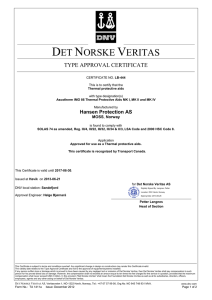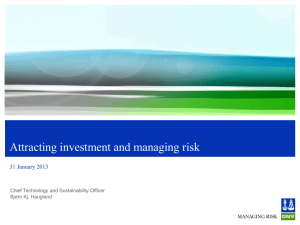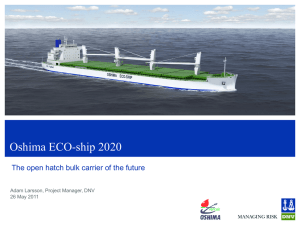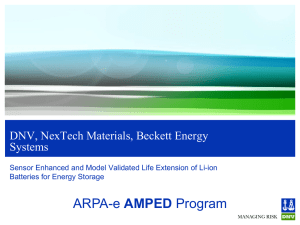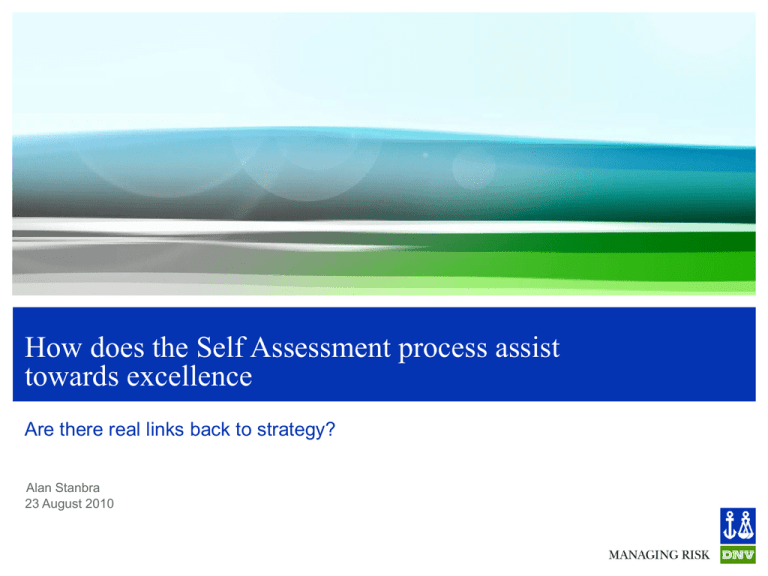
How does the Self Assessment process assist
towards excellence
Are there real links back to strategy?
Alan Stanbra
23 August 2010
Today’s talk agenda
1. Introductions
2. Why Business Excellence
3. Does it work ?
4. Self-Assessment – the benefits and types
5. Case study - Huntsman Polyurethanes
6. Summary and Wrap up
7. Questions
23 August 2010
© Det Norske Veritas AS. All rights reserved.
2
Introduction – about me
Originally an engineer
Joined the ‘Quality Disciples ’ in 1974
A member of the IQA/CQI since 1984
Examiner for the IQA from 1988 – 1992
IRCA Principal Auditor 1988
EFQM Trained Assessor and former BQA Assessor
MSc In TQM and Business Excellence
Joined BMTRADA Certification in 1989
- developed system to achieve Accreditation by NACCB (Now UKAS) in 1990
Approached to join DNV in 1993
Ran the Certification Business until 2000
Now Commercial Director in our UK Consulting Division
- Responsible for DNV partnership with EFQM
23 August 2010
© Det Norske Veritas AS. All rights reserved.
3
DNV-Highly skilled people across the world
300
100
10,000
offices
countries
employees, of which 76% have
university degree
23 August 2010
© Det Norske Veritas AS. All rights reserved.
4
DNV - Integrity at the core
Independent foundation established in 1864
Self-owned with no shareholders
Stakeholders are represented in our governing bodies and committees
We use profits to continuously develop our people and our research and innovation
23 August 2010
© Det Norske Veritas AS. All rights reserved.
5
A trusted player in shipping
130
21.9%
15.5%
Authorised by 130 national maritime
authorities
DNV classed 21.9% of all newbuilding of ships in 2008 (in Gross
Tonnes)
15.5% of the world fleet is to DNV
Class (in Gross Tonnes per 08/2009)
23 August 2010
© Det Norske Veritas AS. All rights reserved.
6
Expert role in the oil and gas industry
65%
40%
30%
65% of the world’s offshore pipelines
are designed and installed to DNV’s
pipeline standard
40% of the world’s Floating
Production, Storage and Offloading
vessels (FPSOs) are to DNV class
30% of the world LNG terminal
projects are supported by DNV
23 August 2010
© Det Norske Veritas AS. All rights reserved.
7
A global business assurer
5,000
More than 5,000 food companies
certified by DNV
Top 3
70,000
2,200
DNV is among the world’s top three
certification companies
More than 70,000 management
system certificates under more than
80 accreditations
2,200 healthcare-related organisations
have had their quality management
system certified by DNV
23 August 2010
© Det Norske Veritas AS. All rights reserved.
8
Impacting climate change issues
1st
Released the world’s first standard
for qualification of carbon capture
technology
48%
75%
15%
48% of all Clean Development
Mechanism (CDM) projects are
validated by DNV
75% of the world’s offshore wind
projects are certified and verified
by DNV
Launched a global rating system for
emission from ships and programmes
to reduce emissions by 15%
23 August 2010
© Det Norske Veritas AS. All rights reserved.
9
DNV and EFQM
Memorandum between DNV and EFQM signed in 2004
DNV is EFQM’s strategic partner for
- Risk Management – EFQM RM Framework
- Knowledge Management – EFQM KM Framework
DNV Contributed to the EFQM Framework for Corporate Social
Responsibility
DNV hosted the EFQM Learning Edge in 2006 and several
times have spoken at the Learning Edge Conferences
23 August 2010
© Det Norske Veritas AS. All rights reserved.
10
Let’s get started -The Model
23 August 2010
© Det Norske Veritas AS. All rights reserved.
11
The Fundamental Concepts of Excellence
23 August 2010
© Det Norske Veritas AS. All rights reserved.
12
Some Benefits -The EFQM Official Message
Satisfied and loyal customers
Successful leaders
A common sense of purpose
throughout the organisation
Constant, well managed
change
Engaged and motivated
people and other
stakeholders
An upward flow of ideas
Efficient and effective use of
data
Efficient and effective
operation
Pride and the desire that
drives further improvement
Minimal fire-fighting /
recurring problems
Innovation is the norm
Excellent results, including
good financial performance
23 August 2010
© Det Norske Veritas AS. All rights reserved.
13
13
Dr Vinod R Singhai Research
100%
90%
86%
Award Winners
Benchmark Firms
67%
Percent Change
80%
70%
62%
60%
50%
43%
40%
37%
32%
30%
22%
20%
12%
10%
0%
13%
6%
7%
0%
Operating
Income
Sales
Return on Return on
Sales
Assets
Total
Assets
Employees
Research study by Dr. Vinod R. Singhal, College of Management, GIT, Atlanta & Kevin Hendricks of Richard
Ivey School of Business at University of Western Ontario, Canada.
23 August 2010
© Det Norske Veritas AS. All rights reserved.
14
WIFM: Typical benefits for:
Leaders
Help deliver the strategy
Understand what is important to do as a leader
Develop a unique culture where excellence is the norm
Management
See the link between strategy and operations
Engage employees in change
Lead improvements
Employees
Provide their input to build a common direction
Understand the impact of their action
Contribute to progress
Future Focus
Key results
Innovation
Sustainability
Reactive to change in the environment
23 August 2010
© Det Norske Veritas AS. All rights reserved.
15
15
Why Business Excellence? Research results
The vast majority of organisations use business excellence self-assessments to identify
opportunities for improvement—as well as their areas of strength—and put in place actions to
move forward.
When used as a basis for an organisation’s improvement culture, the business excellence
model criteria broadly channel and encourage the use of best practices into areas where their
effect will be most beneficial to performance.
Research by Mann and Grigg identified at least 82 countries with national business excellence
awards.
Award programmes had the following common objectives:
Communication, publication and sharing of best practices
Fostering of continuous management, organisational quality, and process improvement
Promotion of an awareness of quality management
Promotion, support, strengthening and enhancement of competitiveness
Recognition of performance excellence, best practices and benchmarks
Understanding the requirements for performance excellence.
23 August 2010
© Det Norske Veritas AS. All rights reserved.
16
Challenges of Implementing the Model
1.
Lack of commitment of leadership;
2.
Lack of involvement of Leaders and Managers;
3.
Lack of understanding that model can be used to operate the
business;
4.
Lack of awareness of benefits of implementing the model;
5.
Expecting quick results/ solution to all our problems
6.
Lack of understanding that Enablers cause results
7.
Inability to enthuse all people within the organization to adopt
the model;
23 August 2010
© Det Norske Veritas AS. All rights reserved.
17
Challenges of Implementing the Model ……
8.
Limited implementation;
9.
Improvements are not institutionalized;
10.
Lacks vertical integration (Vision, Mission, Strategy,
Processes, Measurement & Review)
11.
Ineffective Benchmarks/ benchmarking.
12.
Too many initiatives going on at the same time confuses
people;
13.
Use of excuses like:
We are different.
We will develop our own model
Implementing model requires too much effort. It is not
worth it.
We do not need a model to tell us how to run our business.
-
23 August 2010
© Det Norske Veritas AS. All rights reserved.
18
Ricoh use of self -assessment
EFQM Self Assessment
3 Year Plan
Annual Business Plan
Balanced Scorecard
Process Management
Performance management
23 August 2010
© Det Norske Veritas AS. All rights reserved.
19
Why Measure?
Measurement is the basis for improvement
If you can’t measure it,
you can’t analyse it
If you can’t analyse it ,
you can’t manage it
If you can’t manage it,
you can’t control it
If you can’t control it,
you can’t improve it
23 August 2010
© Det Norske Veritas AS. All rights reserved.
20
The Self Assessment Commitment Journey
Where is
our destination?
Where are we now?
Aims &
Expectations
?
CURRENT
SITUATION
DESIRED
SITUATION
Understanding the Distance
Management
System Models –
PDCA,EFQM
Elements
Enablers
Key Activities
Best practice examples
23 August 2010
© Det Norske Veritas AS. All rights reserved.
21
Steps towards becoming GREAT
Leading
Practicing
Defining
Defining
Emerging
• Nothing in
place
• Service quality
issues not
recognised
• Need recognized
• Visible system in place
• Way of life
• Some action taking place
• Significant compliance
• Full and demonstrable compliance
• Evidence of management
commitment to develop and
improve
• Evidence of review and
refinement
• Prevention-based systems
• Organisational commitment
drives towards defined
performance goals
• “Best in Class” industry leadership
role emerging
• Service quality issues being
identified and understood
• Quality of services being actively• Continual improvement of quality
management and performance
managed
23 August 2010
© Det Norske Veritas AS. All rights reserved.
• Performance envelope being pushed
22
Journey to become GREAT
A good measurement tool lets you see what the
summit looks like and gives guidance on how to
get there
Leading
A Great Company
Practicing
A Good Company
Current status
Defining
Protocol
Emerging
23 August 2010
© Det Norske Veritas AS. All rights reserved.
23
The DNV approach
Where are
we now?
Where is our
destination?
Work Package 1
Work Package 2
- Clarity on
objectives and
risks
- Define
expectations
- Understand current
position
- Confirm approach
and programme
- Define ‘Great’
- Identify
development
needs
- Ensure
compatibility with
previous initiatives
Understanding
the Journey
Work Package 3
Work Package 4
- Develop Tools to
guide development
- Guidance to
Managers
- specific action
plans and support
- Tools
- Roll out
- Testing and Review
- Benchmarking
- Awareness and
competence
- Stakeholder buy-in
and ownership
- Monitoring and
review framework
- Mobilise resources
23 August 2010
© Det Norske Veritas AS. All rights reserved.
Sustaining
24
Self Assessment – does it work ?
Lascelles and Peacock (1997) refer to the contribution of selfassessment to learning:
About the strengths and areas of improvement for the company,
What excellence means when applied to our company,
The status of the progress of development and the target,
Benchmarking own company with others,
Where to focus the resources.
Self- Assessment provides a vehicle, an opportunity and the
means for an organisation to clearly discover its strengths,
weaknesses and areas where improvements can be made, at a
pace or speed that can be controlled.
23 August 2010
© Det Norske Veritas AS. All rights reserved.
25
Steps Following Self –Assessment - Research
Van der Wiele et al’s research also shows that the five most important steps
post self-assessment were:
The development of a business unit and implementation plan
The outcomes of the self-assessment are linked to the business planning
process
There is a need to develop a strong link between the self-assessment
results and the recognition of teams and individuals
Senior Management monitors improvement against targets
Business unit management presents its improvement plans to senior
management
They used a research questionnaire of 117 organisations across Europe in
a survey funded by the EFQM
23 August 2010
© Det Norske Veritas AS. All rights reserved.
26
Conclusions from the research
The results of the survey and the team’s conclusions strongly support the benefit of
self-assessment with respect to links to business improvement.
‘ Which are the most important steps in undergoing a self-assessment ‘-the two
most important identified were
The ability to Benchmark was seen as an essential feature of self-assessment
The learning point that the link between cost reduction and self-assessment is
recognised.
A summary of the results shows that
76% of the respondents found that self-assessment identified opportunities for
improvement
68% stated that self-assessment provided a new motivation for the improvement
process
62% used self-assessment to manage their business
23 August 2010
© Det Norske Veritas AS. All rights reserved.
27
RADAR
Approach:
Sound
Integrated
Results:
Relevance and usability
Scope
Integrity
Segmentation
Performance
Trends
Targets
Comparisons
Causes
Assess and Refine:
Measurement
Learning and Creativity
23 August 2010
Innovation
© Det Norske Veritas
AS. All rights reserved.and Improvement
Deployment:
Implemented
Systematic
28
Types of Self Assessment - Questionnaire
A questionnaire sent to all employees or a selection of personnel/functions.
Questions can be either yes/no or a rating of performance.
The EFQM provide a generic questionaire which is really aimed at gathering
information to allow a more informed decision of how much work is going to be
needed before embarking on a more formalised approach.
The Pro’s to this approach is that it can be used across all levels involving many
people and is quite quick. The results can then be used to stimulate discussion.
The downside of this approach is that accuracy (like all the approaches) is a
problem.
There is no objective evidence to support any of the statements,
It is very generic and can set the organisation off on the wrong foot.There is no
creation of areas for improvement.
23 August 2010
© Det Norske Veritas AS. All rights reserved.
29
Types of Self Assessment - Workshop
The concept of this approach is to involve a cross section of personnel ,especially
management to agree via a workshop a score against the sub-criteria based on
some evidence given by those responsible.
Requires active involvement of the management team of the unit,
FullyTrained assessors are needed as facilitators,
A minimum of one day training for the management team after Data gathering by the
management team
One of the early learning opportunities. Sufficient time needs to be allocated for data
gathering.
Presentation and discussion about scoring, strengths and areas of improvements for
each criteria. Consensus reached.
Agree improvement actions and reviewing progress
The pro’s of this approach are that it involves management, can identify some AFI’s,
builds teams, initiates some assessment to gather information, enables a common
understanding of the model and can create criteria ‘Champions’
The Cons of this approach is that the success depends on the preparation and the
scores can be unrealistic- everyone believes they are better than they are
23 August 2010
© Det Norske Veritas AS. All rights reserved.
30
Types of Self Assessment - Matrix
This consists of a series of statements of achievements against a number of points on a scale
of own choice.
Can be used at any level of the organisation by the management team or a selected group of
people. The matrix chart is part of a four steps workshop approach:
Step 1: The briefing including introduction of team members
Step 2: Individual rating - Each team member rates the various statements in a workbook
Step 3: Consensus meeting -Team meets for a consensus workshop with a facilitator
Step 4: Action planning - Consensus rating and discussion notes are used as a basis for
producing and implementing an improvement action plan
The Pro’s of this approach
It can involve many levels but ensures the involvement of the management team.
It facilitates discussion and gives good ideas on the ‘gaps ‘ between the onganisation and
business excellence and provides an opportunity for team building.
Continued use of the approach can indicate the rate of progress.
The Cons of this approach
No score to benchmark against other organisations ,
23 August 2010
© Det Norske Veritas AS. All rights reserved.
31
Types of Self Assessment – Award Simulation
A replica of entering for the European or a national quality award.
This involves the use of trained assessors/external consultants and has a high
impact on resources.
The assessors go through the organisation carrying out a full assessment against
the criteria of the model. A full report is written , up ot 75 pages containing the
strengths, AFI’s and potential score.
The Pro’s of this is that it is a realistic assessment of organisational excllence by
trained assesors. The whole of the organisation is involved, there is no hiding place
for management and is a platform for business improvement.
The Con’s are that it is costly both in time and resource and once the organisation
has the results there can be a management cover up of the results due to
embarrasment.
The score and benefits are once again subject to the training/expertise/experience
of the assessors.
23 August 2010
© Det Norske Veritas AS. All rights reserved.
32
Pro’s and Con’s of Self Assessment Methods
23 August 2010
© Det Norske Veritas AS. All rights reserved.
33
Effort versus Quality of Data
23 August 2010
© Det Norske Veritas AS. All rights reserved.
34
The Philips Way
23 August 2010
© Det Norske Veritas AS. All rights reserved.
35
The EFQM Excellence Pathway
Starting out
On the Way
Advanced
Recognition
Committed to
Excellence
Recognised for
Excellence
EEA Applicant
Learn from others
Benchmarking
Share Good Practice
Simple SelfAssessment Tools
Business Excellence
Matrix
Full Assessment Tools
Journey towards
Excellence
Leaders for
Excellence
EFQM Assessor
Training
Sharing
Assessment
Training
Increasing maturity
23 August 2010
© Det Norske Veritas AS. All rights reserved.
36
36
Case Study – Huntsman Polyurethanes Europe
Multi-Billion Chemical company part of the Huntsman Group
Originally part of ICI
Plants in the UK, Belgium, Holland Italy and Germany and
sales offices throughout Europe
Provider of insulation materials protective coating and MDI
based products for a variety of industries including
Automotive, Food, and Furniture sectors
The following slides are extracts from an internal HPU
presentation, reproduced with their permission
23 August 2010
© Det Norske Veritas AS. All rights reserved.
37
Process is a fundamental part of any business strategy
EFQM Model
Hay McBer Leadership model
Job and
Organisational
Design
People
Processes
Leadership
People,
Customer,
Society
Results
Strategy
Products
& Services
Markets
Customers
Products
Services
Business
Results
Management
Team
Key
Results
Competencies
Synergy
Organisational
Climate
Business
Strategy
Partnership
& Resources
Management
Systems
& Practices
Hax business Model
Organisation,
information &
communication
Processes are not bureaucracy to hinder but
enablers for business delivery
Structure
Planning
process
Strategy
Process
Leadership
Culture
Performance
The process
is a loop
Control &
reward
Business
process
Processes must be totally linked to the strategically
aligned to business performance
23 August 2010
© Det Norske Veritas AS. All rights reserved.
38
Business processes enhance performance
Business processes are:
A structured framework aligned to deliver any business strategy
Value adding by balancing effectiveness and efficiency
Deliver indication and results of strategic goals
Allow a framework for decision making in key areas
Uses real data that measures current performance innovation
Give a high level of stakeholder confidence by identifying risk and managing
accordingly
Core business processes should be
Derived from the
strategy
Barrier to entry
For competition
Be applied effectively and efficiently
23 August 2010
© Det Norske Veritas AS. All rights reserved.
39
Value adding to
The business
Choosing the correct core processes
Many Business processes
HPU Core Processes??
innovation,
Technology
research and development,
People
technology acquisition,
Planning
information and knowledge management,
Metrics
supply chain management,
supplier partnering,
Core process is where critical business
decisions need to be made
outsourcing,
mergers and acquisitions,
How
global expansion,
OPERATIONS
BAP / metrics
project management, and
NEW BUS DEV
BAP / metrics
FIN
BUS&RESULTS
SHA SERV
BAP / metrics
sales and marketing
ASIA - BAP / metrics
AMERICAS - BAP / metrics
EHS
What
-
Capital expenditure
Budget process
EUROPE – BAP/metrics
Forecasting
EUROPE - BAP / metrics
etc
23 August 2010
© Det Norske Veritas AS. All rights reserved.
AMERICAS – BAP
BAP/metrics
/ metrics
40
PEOPLE
BAP / metrics
Review Core processes
Analysis of enablers :
Efficiency – Delivered with appropriate effort, resource and cost
Effectiveness – Does it deliver the promise
Define the core processes and related sub processes
Name process owner for specified area
Define process steps
Assess effectiveness and efficiency of defined process
Use assessment framework
-
Results – correct measurement and indicators
Approach – needs to be sound and integrated
Deployment – Systematic and sustainable
Assess - Measurement
Refine – Learning, creativity and innovation
23 August 2010
© Det Norske Veritas AS. All rights reserved.
41
Best Practice of Process Management
Best Practice states – Processes are designed to manage and optimize stakeholder
value, excellent organizations:
- Analyze, categorize and prioritize their end to end processes as part of their
management systems and adopt appropriate approaches to effectively manage
and improve them, including beyond the boundaries of the organization.
- Clearly define process ownership and their role and responsibility in developing,
maintaining and improving the framework of the key processes
- Develop meaningful process performance indicators and outcome measures,
clearly linked to the strategic goal
- Turn new ideas into reality through innovation enabling processes that fit the
nature and importance of the changes they will make.
- Assess the impact and the added value of innovations and improvements to
process
23 August 2010
© Det Norske Veritas AS. All rights reserved.
42
EFQM Self-Assessment and performance improvements
Strategy execution
Cause-effect
Agility
Level 5
+
Strategy
Integration
Systematic implementation
Regular reviews
Level 1
Educating people
Measuring the right things
Doing the right things
43
23 August 2010
© Det Norske Veritas AS. All rights reserved.
43
Global Process Improvement
OPERATIONS
BAP / metrics
NEW BUS DEV
BAP / metrics
FIN
BUS&RESULTS
SHA SERV
BAP / metrics
ASIA - BAP / metrics
AMERICAS - BAP / metrics
AMERICAS – BAP
BAP/metrics
/ metrics
EUROPE – BAP/metrics
EUROPE - BAP / metrics
23 August 2010
© Det Norske Veritas AS. All rights reserved.
44
PEOPLE
BAP / metrics
Quote
J A Darby - Huntsman European Systems
Improvement Manager ‘We believe that in many
areas we have been able to recover from the
recession much quicker than in previous cases - for
example, in our Automotive Business, instead of the 5
years predicted to recover from a slump of 30%, it
has only taken 2 years. Furthermore, we believe that
this growth is sustainable because it is mainly due to
new business at new customers, achieved through
our automotive new product development process’.
23 August 2010
© Det Norske Veritas AS. All rights reserved.
45
Summary of research
The benefits of self assessment are well documented in many
research papers and evidenced in some key companies
Measure and target improvements: and provides a strong predictor of long term survival
Provides an opportunity to ensure that activities designed to the operation are fully integrated
with the organisations strategies and plans
Highlight and share best practices and provides a useful analysis of the capability of the
organisation
Internal and external comparisons may disclose overlooked strengths and identify best
practices
General and specific comparisons with external organsations based on a common framework
Provide a strategic direction (produce a visionary “role model” of excellence.
Measure progress and integrate current and past initiatives and maintain focus and
commitment over time
Helps to accelerate change
“Quality is an endless journey: like walking towards the horizon – no matter
how far you walk, it does not change where the horizon is” – (Bernard
Fournier, CEO Rank Xerox)
23 August 2010
© Det Norske Veritas AS. All rights reserved.
46
But the question is?
Whilst there is very strong evidence
that many benefits are gained as a
result of self-assessment there is
precious little evidence of a linkage or
influence in the strategy or direction
of organisations and it is seen by
management as simply a tool to
identify process improvements
23 August 2010
© Det Norske Veritas AS. All rights reserved.
47
THANK YOU AND
ANY QUESTIONS
23 August 2010
© Det Norske Veritas AS. All rights reserved.
48
Safeguarding life, property
and the environment
www.dnv.com
23 August 2010
© Det Norske Veritas AS. All rights reserved.
49

